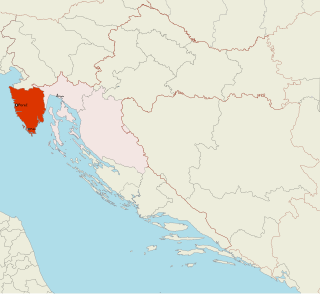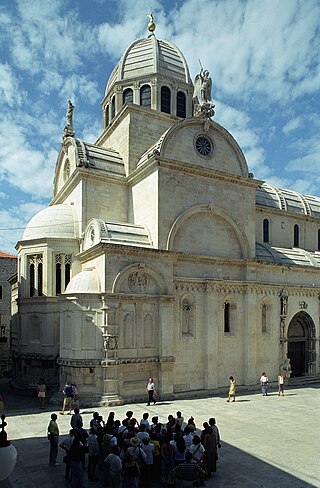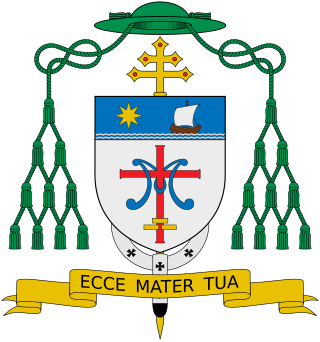
Tragurium, Ancient Latin name of a city in Dalmatia (coastal Croatia), now called Trogir, was a bishopric until 1829 and a Latin titular bishopric until 1933. [1] [2]

Tragurium, Ancient Latin name of a city in Dalmatia (coastal Croatia), now called Trogir, was a bishopric until 1829 and a Latin titular bishopric until 1933. [1] [2]
In 1050 Tragurium became the seat of a diocese also known as Traù (in curiate Italian) or Trogir in Croatian.
On 1 May 1298 it lost territory to establish the Diocese of Šibenik.
On 30 June 1828, the residential see was abolished by papal bull Locum Beati Petri , a Croatian dioceses reshuffle, which divided its territory over the then Roman Catholic Diocese of Split–Makarska and its own above daughter Šibenik.
Since 1933 the bishopric was nominally restored and is on the Catholic Church's list of titular sees. [11]
It has had the following incumbents, all of the lowest (episcopal) rank :

Trogir is a historic town and harbour on the Adriatic coast in Split-Dalmatia County, Croatia, with a population of 10,923 (2011) and a total municipal population of 13,192 (2011). The historic city of Trogir is situated on a small island between the Croatian mainland and the island of Čiovo. It lies 27 kilometres west of the city of Split.

Rab [ɾâːb] is an island in the northern Dalmatia region in Croatia, located just off the northern Croatian coast in the Adriatic Sea.
The Latin Patriarchate of Alexandria was a nominal patriarchate of the Latin church on the see of Alexandria in Egypt.

Krbava is a historical region located in Mountainous Croatia and a former Catholic bishopric (1185–1460), precursor of the diocese of Modruš and present Latin titular see.

Strongoli is a comune and town with a population of over 6000 people in the province of Crotone, in Calabria, southernmost Italy.

The Archdiocese of Split-Makarska is a Latin Metropolitan archdiocese of the Catholic church in Croatia and Montenegro. The diocese was established in the 3rd century AD and was made an archdiocese and metropolitan see in the 10th century. The modern diocese was erected in 1828, when the historical archdiocese of Salona was combined with the Diocese of Makarska. It was elevated as an archdiocese and metropolitan see in 1969, restoring the earlier status of the archdiocese of Split, as it is also known. The diocese was also known as Spalato-Macarsca.

The Metropolitan Archdiocese of Rijeka is a Latin Catholic Metropolitan archdiocese in Croatia.

The Roman Catholic Diocese of Poreč and Pula is a suffragan Latin diocese in the ecclesiastical province of the Metropolitan Archdiocese of Rijeka on Istria peninsula, in Croatia.

The Diocese of Šibenik is a Latin diocese of the Catholic Church located in the city of Šibenik in the ecclesiastical province of Split-Makarska in Croatia.

The Archdiocese of Tiranë–Durrës is a Latin Church Metropolitan archdiocese of the Catholic Church in Albania.
The Diocese of Knin was founded in 1050 and is today a titular see of the Latin Church of the Catholic Church. Its cathedra was located in Knin, Croatia.
The Roman Catholic Diocese of Suacia was a bishopric with see in the town of Svač, which is today the village lying to the east of Ulcinj in Montenegro that is called in Serbian Шас, in Croat Šas and in Albanian Shas.

The Roman Catholic Diocese of Karaganda is a Latin diocese of the Catholic Church, suffragan in the ecclesiastical province of the Metropolitan of Mary Most Holy in Astana, yet remains subject to the missionary Congregation for the Evangelization of Peoples.

Dalmatian city-states were the Dalmatian localities where the local Romance population survived the Barbarian invasions after the fall of the Western Roman Empire in the 400s CE. Eight little cities were created by indigenous inhabitants who maintained political links with the Eastern Roman Empire which defended these cities, enabling their commercial trade.
The Roman Catholic Diocese of Lettere-Gragnano was a Latin Catholic diocese located in the commune of Lettere in the Metropolitan City of Naples in the southern-central Italian region Campania. In 1818, it was merged into the Diocese of Castellammare di Stabia.
The Diocese of Novigrad was a Latin Church ecclesiastical jurisdiction or diocese of the Catholic Church located in the city of Novigrad, Istria, Croatia until it was suppressed to the Diocese of Trieste in 1831.
The Diocese of Arbe or Diocese of Rab or Diocese of Arba was a Roman Catholic diocese located in the town of Arbe on the Croatian island of the same name located just off the Adriatic coast of northern Dalmatia, in Croatia, where still stands the former cathedral, dedicated to the Assumption of Mary.
The Diocese of Cephalonia and Zakynthos was Roman Catholic diocese located on the Ionian Island of Cephalonia. It was suppressed in 1919.
Stefano Cupilli, C.R.S. (1659–1719) was a Roman Catholic prelate who served as Archbishop of Split (1708–1719) and Bishop of Trogir (1699–1708).

The Cape Planka is a cape of Croatian shore of the Adriatic Sea located 2 kilometres (1.2 mi) southeast of village of Rogoznica in the Šibenik-Knin County. The cape is the most prominent point of land along the Dalmatian shore. It represents a geographic and climatological boundary of the northern and the southern Adriatic often characterised by strong sea currents and swells as weather systems from the north and the south come in contact. There is a navigational beacon at the cape.